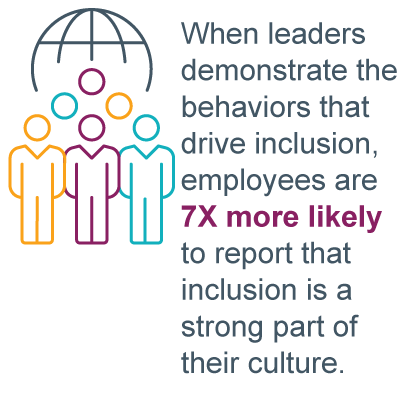“Are you sure your leaders really know how to create an inclusive environment?”
I find myself asking clients this question too many times to count. Usually, this conversation occurs after they’ve told me that they’re struggling to reach their diversity, equity, and inclusion (DEI) goals. And it’s really hard to pinpoint where they’re going wrong.
Part of the problem is that companies want to make change fast. Don’t get me wrong—goals are a good thing. And DEI efforts are long overdue.

But company leaders need to recognize that a cultural transformation has to take place for DEI to thrive in your organization. Otherwise, your company becomes a revolving door. You can hire diverse talent all you want. But if your leaders don’t cultivate an equitable and inclusive work environment, people will head straight for the door.
Creating an Inclusive Workplace: Leaders Are Key
That phenomenon plays out clearly in the data. In our Diversity, Equity, and Inclusion Report 2023, we found that women and minorities (a note on terminology) at every level are significantly more likely than men and non-minorities to say they need to change companies to advance their careers.
Between these groups, there was little difference in satisfaction rates of their advancement, development opportunities, performance expectations, or work-life balance. And in many cases, minorities reported more favorable rates in these areas. Rather, the underlying factors behind their intention to stay or leave were primarily related to the environment created by their company’s leaders. Here are the top drivers of why leaders from diverse backgrounds stay to advance their careers:
- Senior leaders have built strong trust.
- Managers provide opportunities for team members’ growth and development.
- Organizational leaders have strong interpersonal skills.
- Managers listen and respond with empathy.
Our research shows that a diverse, fair, inclusive, and trusting culture can make all the difference, especially when it comes to attracting and retaining talent.
This problem isn’t easy to solve immediately. But what’s important is that companies begin moving in the right direction by teaching leaders how to create an inclusive environment.
Great Leadership Is Inclusive Leadership

One of the biggest mistakes companies make is excluding inclusion training from the rest of their leadership development goals. As a result, this disconnected approach may make leaders feel that inclusion isn’t part of their daily work, nor their responsibility.
But that’s the opposite of reality. Leaders shouldn’t think about inclusion as a behavior that is separate from everything else they do. Rather, by definition, inclusion is woven into how people operate. It should be part of the way leaders communicate, interact, run meetings, give assignments, etc., every single day.
Our research shows that when leaders consistently demonstrate effective behaviors that drive inclusion, employees are 7X more likely to report that inclusion is a strong part of their culture. Why? Because leaders who know how to create an inclusive environment on a daily basis create a better work environment for everyone, regardless of background.
In fact, I’d argue that to be a great leader, one must be an inclusive leader. Quite simply, great leadership is inclusive leadership.
7 Inclusive Leadership Skills Every Leader Needs

Usually when I share my perspective about inclusive leadership while facilitating courses or coaching executives, I see a lot of nodding heads. Generally speaking, leaders want to say and do the right things. But they don’t know how to get started.
That’s why it’s critical to identify and train for specific, concrete leadership behaviors that actually help leaders be inclusive. We surveyed our clients to get a better understanding of the challenges they hear from their leaders. And we conducted research to gain a deeper understanding of what inclusion in the workplace looks like on a daily basis.
We found that there are seven key skills that help leaders create an inclusive work environment. These skills have the most impact as your leaders start learning how to create an inclusive environment.

1. Build Empathy
What we hear: When it comes to empathy, leaders just don’t “get it.”
What to do: Inclusion must start with empathy. Why? Leaders need to be able to put themselves in the shoes of everyone on their team to truly connect with them.
Unfortunately, empathy is rarely a part of how a company operates. More often, company policies and procedures make it difficult for leaders to demonstrate empathy. Such policies include mandates on working in the office, organizations that track keystrokes, or the reinstatement of forced ranking in performance management systems.
To foster empathy in the workplace, leaders need to model it. But for some leaders, it’s a challenge to connect with the feelings of exclusion, especially if they’ve never experienced it themselves. That’s why it’s so critical that leaders have the opportunity to understand and experience being excluded and connect to it emotionally.
There are ways to accomplish that, such as reading books or having discussions. Still, reading and discussing exclusion can’t compare to actually experiencing it. We’ve found that one of the most effective ways to experience being excluded firsthand is using virtual reality simulations.
Our advice: Don’t save empathy for a crisis. Start building empathy now so that leaders have a stronger connection before a crisis happens.

2. Communicate Inclusively
What we hear: Leaders lack insight about the potential effects of their communication style.
What to do: Daily communication is at the core of creating an inclusive workplace culture. Conversations with others can make or break inclusion. Subtle words and unintended moments of exclusion by a leader or team member can make people feel unwelcome, not valued, and disengaged.
Inclusion happens in the micro-moments of a leader’s interactions. Leaders must be aware of the words they use and how their words are received by others.
Everyone has personal and practical needs and is seeking for them to be met in daily interactions. In every conversation, leaders should keep these Key Principles in mind:
- Maintain or enhance self-esteem so people feel valued and respected.
- Listen and respond with empathy so people feel listened to and understood.
- Ask for help and encourage involvement so people feel involved.
- Share thoughts, feelings, and rationale to build trust.
- Provide support without removing responsibility.
Our advice: The leader's role in creating an inclusive environment starts with modeling effective communication skills and advocating for inclusive behaviors. When leaders communicate inclusively, people are more likely to develop a sense of belonging and feel valued for their unique perspectives, contributions, and experiences.

3. Facilitate Inclusive Meetings
What we hear: The same people tend to dominate meetings, while others are excluded, dismissed, or talked over.
What to do: Inclusion is making sure the right people are involved—for generating ideas and making decisions. We worked with Dr. Steven Rogelberg, a renowned expert on meetings and the science behind them, to reflect on intentional meeting design. Research shows that meetings without a clear purpose disproportionally affect those who are underrepresented at work.
Start your meetings by defining objectives and benefits to mitigate interruptions. By using techniques like partner discussions, chat function, and polling software, people who are more introverted and reserved may be more easily heard. To ensure virtual meeting attendees are included and engaged, leaders can share materials beforehand to draw people in to create space for equal airtime in discussions.
Our advice: Creating and communicating ground rules to foster inclusivity provides equal participation opportunities. Developing these practices for leading effective meetings creates psychological safety and a place where people can be their whole, authentic selves.

4. Delegate for Opportunity
What we hear: Leaders tend to give the important projects to the same superstars over and over again.
What to do: Leaders must be more thoughtful about who receives opportunities. This starts with thinking about the capabilities, development needs, motivators, and availability of all team members.
Prior to delegating tasks or assignments, leaders should answer the following questions:
- What assumptions am I making?
- Where am I unsure of what someone can do or wants to do?
Our advice: When it comes to delegation, leaders often think it’s all or nothing. And because they’re busy, they opt for the path of certainty and least resistance. But leaders should think about delegation differently. They can delegate idea generation, tasks, and authority separately. By considering how to allocate the different parts of the project, leaders can be more inclusive with project assignments, rather than basing delegation on habit or favoritism.

5. Give Honest Feedback
What we hear: Our managers are uncomfortable giving feedback for improvement, especially to people who are different from them.
What to do: In general, a lot of people avoid giving feedback for improvement because they are uncomfortable with conflict. And when there are perceived differences between people, leaders may struggle even more to predict how someone will react. As a result, they avoid giving feedback, which prevents their team member from getting the feedback they need to grow.
On the flip side, some leaders may be too comfortable giving feedback for improvement. In particular, they may struggle to understand someone’s different point of view and react negatively without considering the person’s merits.
Leaders should adjust their feedback style for the needs of the person they’re giving feedback to. For example, minorities and women frequently report that they have less clarity about what is required for success, and promotion decisions aren’t always clear.
Our advice: Feedback should be clear, specific, and timely. Leaders can use the STAR method for positive and developmental feedback. The STAR method focuses on giving feedback about behaviors instead of about the person. This approach ensures that those who are already in an underrepresented group don’t feel targeted in addition to feeling like they’re not a part of the “in” group.
Ultimately, it’s the leader’s job to build a culture of ongoing feedback. This is the most effective way to reduce bias. The more diverse a group of feedback providers is, the better the opportunity will be to get a true picture of someone’s performance.

6. Coach for Growth
What we hear: Leaders tend to feel most comfortable coaching people like themselves.
What to do: By avoiding coaching people who are different from them—whether because of gender, background, age, or some other factor—leaders limit others' chances for advancement.
Authentic listening is a critical trait of an effective coach. Proficient leaders listen for content, intent, and emotions. When done well, the leader knows when and where to show empathy. It’s also imperative for the coach to share their own perspective.
Our advice: Leaders who are vulnerable by genuinely acknowledging their own failures can make powerful connections with employees. Vulnerability demonstrates to everyone else that it’s safe to share experiences. It also builds trust, opens the discussion, and enriches everyone’s understanding of differences.

7. Resolve Conflict Fairly
What we hear: Managers try to avoid conflict and often resolve it by trying to maintain the status quo.
What to do: Conflict is natural and necessary for better decision making. After all, everyone has different experiences, points of view, preconceptions, styles, abilities, and motivations. What’s important is that leaders hear and evaluate multiple viewpoints.
To do this, leaders should define and explore identity and cognitive diversity with their teams. Understanding the diversity of the team can establish a strong foundation of valuing differences, both within the team and across the company.
Our advice: Nurturing differences helps people feel appreciated and engaged. It can also help build their commitment to contributing to the team and the company. And teams that understand diversity and have inclusive mindsets will be less likely to escalate differences into conflict.
How to Create an Inclusive Environment: Create Great Leaders
The most critical part of creating inclusive workplaces is to practice being inclusive every single day. These micro-moments add up to create a culture of equity, inclusion, and simply great leadership.
At the same time, we need to recognize that we are in this for the long haul. And some days, we will make mistakes.
That’s why I recommend one more essential leadership behavior: the ability to give yourself grace. When we allow room to reflect on our failures, the result can be a powerful learning that transforms relationships, teams, and cultures. Give yourself and your team the space for things to go wrong. Transform mistakes into moments of empowerment.
For more on how to create an inclusive environment, including data and best practices, check out our Diversity, Equity, and Inclusion Report 2023.
Meagan Aaron is a managing consultant for DDI’s US Operations where she started 26 years ago as an intern. When she’s not leading account teams or coaching executives, Meagan can be found designing flower creations for weddings or the home. Living in Memphis has provided her a community to apply her gifts and talents by coaching women business owners and upskilling leaders at nonprofits like the Memphis Metro YMCA.
Topics covered in this blog

